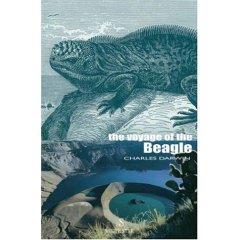| 2020ok Directory of FREE Online Books and FREE eBooks |
Free eBooks > Science > Mathematics > History > The Voyage Of The Beagle
The Voyage Of The Beagleby Charles Darwin  Download Book (Respecting the intellectual property of others is utmost important to us, we make every effort to make sure we only link to legitimate sites, such as those sites owned by authors and publishers. If you have any questions about these links, please contact us.) link 1 link 2 link 3 link 4 link 5 link 6 About Book Book Description Recorded during a remarkable five-year voyage throughout South America, these findings became the foundation of naturalist Charles Darwin's revolutionary theory of natural selection. His writing brings to life an exotic world of natural wonders, transporting readers to Chile, Argentina, the Andes Mountains, and finally, the Galapagos Islands, the unique ecosystem that inspired Darwin's groundbreaking work. Darwin's work is as relevant today as it was more than 100 years ago, when he first revealed his revolutionary theory. Download Description AFTER having been twice driven back by heavy southwestern gales, Her Majesty's ship Beagle, a ten-gun brig, under the command of Captain Fitz Roy, R. N., sailed from Devonport on the 27th of December, 1831. The object of the expedition was to complete the survey of Patagonia and Tierra del Fuego. From the Publisher This book is in Electronic Paperback Format. If you view this book on any of the computer systems below, it will look like a book. Simple to run, no program to install. Just put the CD in your CDROM drive and start reading. The simple easy to use interface is child tested at pre-school levels. Windows 3.11, Windows/95, Windows/98, OS/2 and MacIntosh and Linux with Windows Emulation. Includes Quiet Vision's Dynamic Index. the abilty to build a index for any set of characters or words.
This was a return trip to South America for the Beagle and Darwin left the placid landscape of England to journey to a land of dynamic terrain: high mountains, earthquakes, volcanoes, strange coastlines and even stranger animals and fossils: "Everything in this southern continent has been effected on a grand scale: the land, from the Rio Plata to Tierra del Fuego, a distance of 1,200 miles, has been raised in mass...What a history of geological changes does the simply-constructed coast of Patagonia reveal!...At Port St. Julian , in some red mud capping the gravel on the 90-feet plain, I found half the skeleton of the Macrauchenia Patachonica, a remarkable quadruped, full as large as a camel. It belongs to the same division of the Pachydermata with the rhinoceros, tapir, and palaeotherium; but in the structure of the bones of its long neck it shows a clear relation to the camel, or rather to the guanaco and llama. From recent sea-shells being found on two of the higher step-formed plains, which must have been modelled and upraised before the mud was deposited in which the Macrauchenia was entombed, it is certain that this curious quadruped lived long after the sea was inhabited by its present shells." Darwin spent thousands of hours making observations, collecting specimens, and recording data. He went ashore all along the South American coasts, often riding horseback into the interior in order to collect more data, and he also includes his observations about the people whom he met there, from army generals to local Indians. And of course, he visited the now famous Galapagos Archipelago, the 10 islands formed by volcanic action where Darwin noticed that several species of finches existed, with beak shapes that were vastly different. He thought deeply about the comment made by the vice-governor that there were many different varieties of tortoises to be found on the island, and came to the conclusions about evolution he later elaborated upon in his Origin of Species: "It was most striking to be surrounded by new birds, new reptiles, new shells, new insects, new plants, and yet by innumerable trifling details of structure, and even by the tones of voice and plumage of the birds, to have the temperate plains of Patagonia, or rather the hot dry deserts of Northern Chile, vividly brought before my eyes. Why, on these small points of land, which within a late geological period must have been covered by the ocean, which are formed by basaltic lava, and therefore differ in geological character from the American continent, and which are placed under a peculiar climate, - why were their aboriginal inhabitants, associated, I may add, in different proportions both in kind and number from those on the continent, and therefore acting on each other in a different manner - why were they created on American types of organization?" The Beagle went back to England via Australia and New Zealand, and Darwin continued to collect specimens there as well. He left England as student with a keen and open mind; he returned an experienced scientist with definite ideas about the workings of nature, and raw data to substantiate his theories. He would go on of course to refine them and publish On the Origin of Species by means of Natural Selection, that famous and still controversial book. The direction of Darwin's thought is clearly evident in The Voyage of the HMS Beagle, as well as his exuberance. This is the second edition of the book, originally published in 1845. Fascinating reading from a truly original mind! Related Free eBooks
| Related Tags |












SEND A COMMENT
PLEASE READ: All comments must be approved before appearing in the thread; time and space constraints prevent all comments from appearing. We will only approve comments that are directly related to the article, use appropriate language and are not attacking the comments of others.